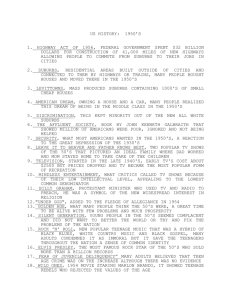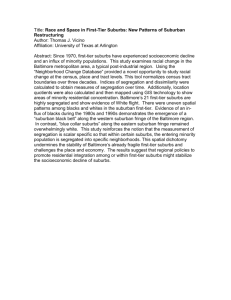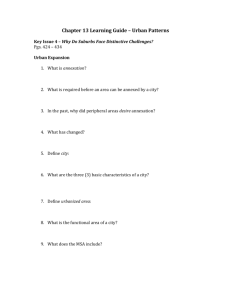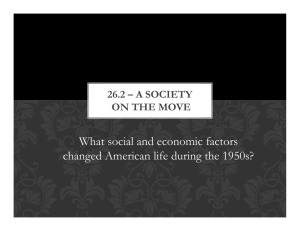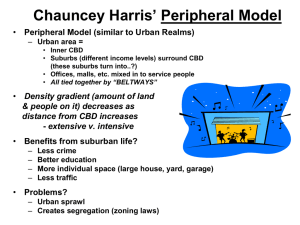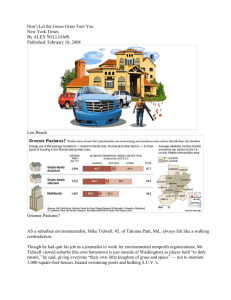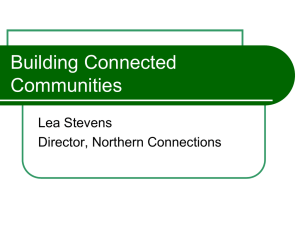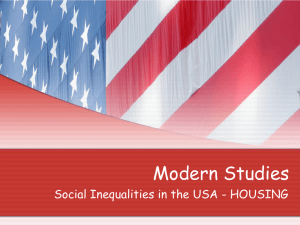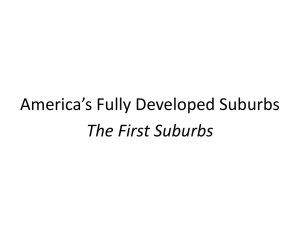suburbanisation AS - Abingdon School Study Site
advertisement
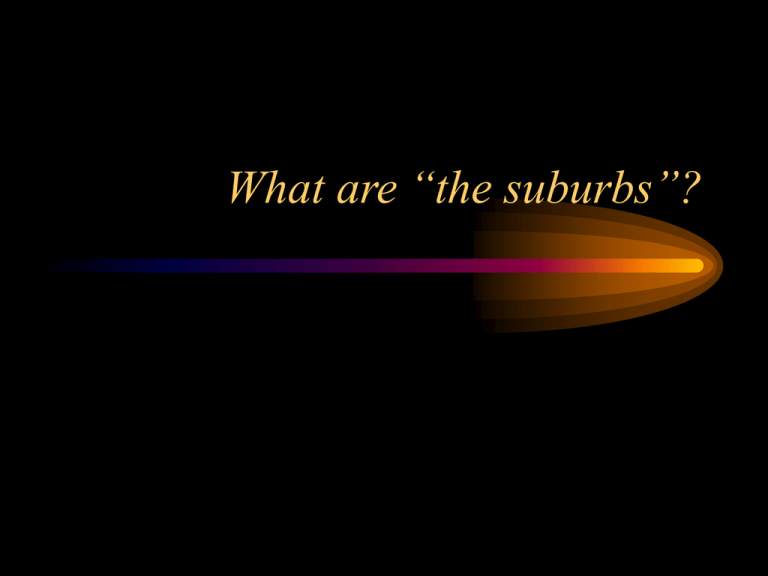
What are “the suburbs”? Definition • Movement of upper and middle-class people from core areas to surrounding outskirts. The process began in the mid-nineteenth century but became a mass phenomenon in the late-twentieth century. • Critical elements – Social stratification – Long history dating from railroad and streetcar suburbs – Phenomenon of the masses since 1950s The pre-suburban industrial city • • • • Industrial revolution Competition for land Clustering of factories in city center Clustering of working class in city center – density – unpleasant living conditions The beginnings of suburbanization • • • • Carriages Horse cars Streetcars Cars – – – – starfish pattern city becomes larger geographically work and home begin to be separated social segregation begins The U. S. suburban population grew from 26.7% in 1950 to 49.8% in 2000. Pop. in Cities, Suburbs, and Nonmetro Areas 1950 to 2000 160 In millions of people 140 120 central cities 100 suburbs 80 nonmetro 60 40 20 1950 1960 1970 1980 years 1990 2000 Suburbanisation is a landhungry process (Phoenix). Suburbanisation as a mass phenomenon after 1950. Phoenix grew by 1 million between 1990 and 2000. Transportation • Freeways and transport corridors increased accessibility of the suburbs. • Critical link between transportation technology and urban form = 4 stages of urban development • (1) pedestrian and horsecar travel from 1800-90 • (2) electric streetcars between 1890 and 1920 • (3) recreational automobiles from 1920-50 • (4) freeways from 1950 to present. Suburbanization increases • Residential suburbanisation continued along streetcar lines • commercial suburbanisation increases – follows population • industrial suburbanisation also increases – invention of truck – high land prices in city center Rise of the automobile • About 1920 automobile ownership rising • Ford improves mass production techniques – cars become more affordable • Government subsidises car travel • Cars out-compete streetcars • Starfish is filled in Why the explosion? • Post-war economic boom – baby boom – returning veterans – pent-up wartime demand • road building – spoke and hub – interstate highway system Social and demographic trends • High fertility of the baby boom era raised the demand for housing. • Large families demanded large homes. • The nuclear family replaced the extended family as the ideal. • Prevailing model of male breadwinner and women as homemakers. Suburban location gave them home, garden, and automobile – cult of domesticity. Results of post-war suburbanization • • • • • starfish filled in city much larger in area much lower population densities separation between home and work increases segregation increases (uses, classes, and ethnicities) The suburban ideal • Post WWII explosion creates “the suburbs” – concrete, material landscape/geography • Simultaneous development of a cultural ideal/image/vision of the suburbs American Dream Elements of the suburban ideal • • • • • • • low-density residential space--separation of home and work clean, quiet, healthy, safe in harmony with nature nuclear family/single family house private life/private space Protestant, white, middle-class Decentralization has had many negative consequences for newer suburban areas • Traffic congestion • Air pollution • Loss of open space • Overcrowded schools A condominium development closes in on the mountains in the background in this Feb. 25, 1997 photo in the south Denver suburb of Littleton, Colorado. Urban sprawl hitting cities like Denver is the fastest growing threat to the environment, says the Sierra Club, citing problems with lost open space and increased air and water pollution. Traffic creeps along Littleton Road (aka route 202) in Parsippany, N.J., during the morning rush hour on Dec. 10, 2003. A new twist on commuting in the New Jersey suburbs. Suburbanites are still commuting, but in many cases their ride to work takes them to other suburbs -- not cities. A real estate sign stands on a rowhouse lawn in the Philadelphia suburb of Collingdale, Pa., May 29, 2002. Across the country, old, often small, suburbs that were among the first to welcome the cities' middle class are now seeing their populations dwindle or stagnate as those of outer suburbs continue to grow. Nowhere is this more apparent than in Delaware County's older suburbs, such as Collingdale, while its western towns are dotted with farms and brand-new developments. Conclusions • Between 1950 and 2000, the U.S. became a suburban nation. 50% of population lives in suburbs. • Growth of suburbs reveals societal forces – transportation technology, residential preferences, housing policy, and demographic change.
